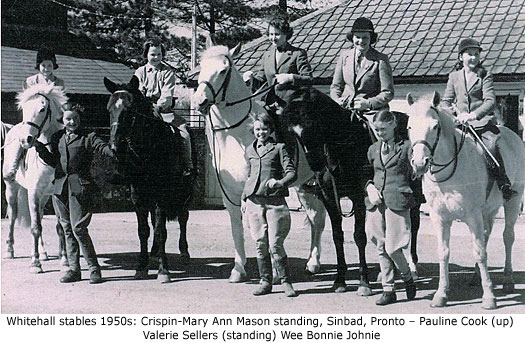|
I thought you might be interested in this photo of my grandfather William Boultwood who lived at 15 Northgate End, next to the former Rising Sun pub. He was employed by G. E. Sworder & Sons in their cattle market and second-hand furniture sale room next door to number 15, which was adjoined to Priors scientific instrument factory where my mother worked in the war.
He was presented with the clock on September 15th 1966 after 65 years service with the company from 1901 to 1966, apart from 4 years away during the great war.
Number 15, the house where I was born on October 8th 1944 was owned by Sworders. My grandparents lived there rent free, provided he was on call 7 days a week for the arrival and collection of furniture for the sales. On many occasions when cattle men were in transit with animals down in their lorries they would knock on the door anytime of the day or night and ask him to open up the market to get the animals out of their lorries and into a safe environment overnight. It was expected that my grandmother would provide coffee for the staff in the office on market day.
Picture (above) shows Mr Robert Trigg in white mac, a director of Sworders, and the bowler hatted man was a Mr Gingell. Both men were referred to as 'Sir' by the drovers. The small man on right of pic was Eddie Bayford who was the self acclaimed market manager.
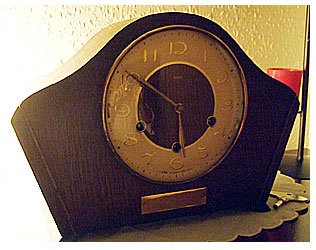 Market day I believe was Thursday and grandfather then spent the next three working days scrubbing the whole market using only a hose and stiff broom. All the old wet straw he piled up in the back of the market yard and grew the most enormous marrows. Market day I believe was Thursday and grandfather then spent the next three working days scrubbing the whole market using only a hose and stiff broom. All the old wet straw he piled up in the back of the market yard and grew the most enormous marrows.
The clock (left) still works perfectly and is on our sideboard next to the photo.
Priors' factory was above the garage up a steep ramp, which in later years was an upstairs showroom for the garage. My grandfather bought me my first car from the garage in 1962, a Ford Anglia.
I remember in the 1950s the factory hooter going off and all the workers running down the slope and out through the metal doors. I think it was called H. Prior and was a major player in the war effort WW2, where they made telescopes and gunsights as well as microscopes and optical magnifying instruments for peace time.
My mother worked there in her youth as she only lived next door at number 15 Northgate End. The upstairs room at the front was where I was born. Mum's maiden name was Boultwood and she met Dad who worked for the Home and Colonial Stores all his life starting as delivery boy and retiring as branch manager in East Barnet.
Mum was born in Furneux Pelham and dad was a resident of Birchanger where his father William Prior worked in the brick making factory as a carpenter. They moved to Oak Street in BS in the 30's. Mum worked at Poulters the drapers in South street after her stint at the factory. I remember she complained of all the brass splinters she got in her hands and decided that shop work was preferable.
In the 1940s there were at least three Michael Prior's in BS. We were all named after the parish church where my Grandfather William Prior was one of the chief bellringers. We still have the handbells that were owned by my grandfather and played regularly in St Michael's church.
Mike Prior, Trowbridge, Wiltshire (2010)
|
|
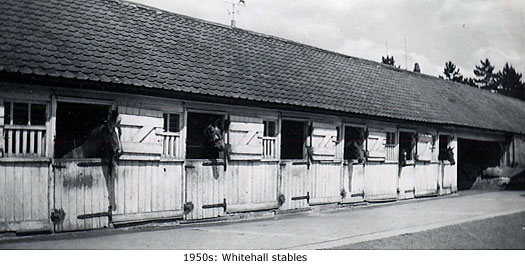
I have recently become a very reluctant user of a computer. The time consuming aspect of hours on the internet was not for me. Then a revelation, I discovered your wonderful website for Bishops Stortford, three hours later I was still enthralled.
I was born in Beverley, Yorkshire in 1934 and that is where the Rhimes family is from. My Mother moved us down to Brighton and Hove at the start of the Second World War. My Uncle P J Rhimes joined the Cavalry of the Line 16th/5th Lancers in 1919, serving in Palestine, India, Egypt, and at home until 1937. When he left the army Colonel Commandant Paul Sangster (another famous horse man) reported that he would make a first rate instructor. For a time he was with Major Faudel-Philips who advised him to open a riding school which he did in Cheshunt, then he moved to Whitehall around 1946 or 1947.
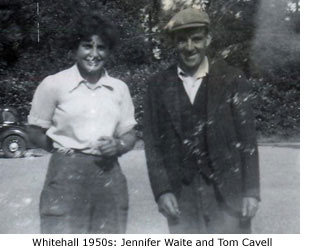 In the early 1950s I trained at Whitehall Riding School under the instruction of my Uncle, Percy J Rhimes. Those far off times hold many happy memories, and one tends to forget the hard days of freezing cold mornings when the two stable yards were like ice rinks. Sometimes we had to be up at 5.00am to plait manes and tails and have the horses ready for hunting with the Puckeridge Hunt. Those evenings would be tough too, spending hours cleaning good old Hertfordshire mud from horses and tack. Fun times were in abundance as well, polo matches at Silver Leys, riding instruction classes, boarding school students from Whitehall, the Puckeridge point-to-point, and training gallops at Stanstead Airport when the Americans were still stationed there. In the early 1950s I trained at Whitehall Riding School under the instruction of my Uncle, Percy J Rhimes. Those far off times hold many happy memories, and one tends to forget the hard days of freezing cold mornings when the two stable yards were like ice rinks. Sometimes we had to be up at 5.00am to plait manes and tails and have the horses ready for hunting with the Puckeridge Hunt. Those evenings would be tough too, spending hours cleaning good old Hertfordshire mud from horses and tack. Fun times were in abundance as well, polo matches at Silver Leys, riding instruction classes, boarding school students from Whitehall, the Puckeridge point-to-point, and training gallops at Stanstead Airport when the Americans were still stationed there.
Summer pony club camps were a highlight in August. The stables would be full to capacity with horses and ponies, with young campers in the field in tents. In 1950 Monica Dickens came with her two nephews; Hal and Philip Danby. Many names came flashing back too, of adults and children who rode with us. The Barden family, the Sellars, the Steggles, Mary Ann Mason, and I have fond memories of Miss Pix and Miss Hill from the teachers training college. I often wonder about the students I trained with; Pauline Cook, Hilary Payne, and Gill Dymock. The list goes on and on. I recall John Sparrow and his two 3 year old Arabs, Joyfull Joshua and Joyfull Jessie who came in for training. I was the first person to ever ride Jessie. I also recall Boyd Gibbons, who occasionally played polo with my Uncle.
A vivid memory is of a horse named Joker who came to us to be clipped out and proved to be extremely difficult. Joker kicked my Uncle very severely and I had to return him to a property with a thatched roof on Dane 'O Coys Lane. It was a most traumatic time as my Uncle nearly lost his life. His Father-in-Law, 'Pop' Anderton did, from the terrible shock of a dreadful situation. People and riding students rallied around to help us carry on with the care of the horses and riding lessons through those awful days, until things finally returned to normal.
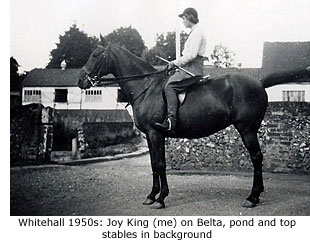 Tom Cavell worked at Whitehall and would occasionally bring live rats in traps down from the piggery. My Uncles two Greyhounds (much to my horror) would dispose of them very rapidly. I was delighted to find your photo of Arthur and Sidney Rayment. I regularly rode horses down to the blacksmith to be shod. I distinctly remember Sid being very wary of any horses that were not well behaved, then big Arthur would assert his authority and calm (and submission on the part of the horse-and Sid) would return. I returned to Whitehall in 1970 and was dismayed to see the stables so dilapidated and deserted. I often wonder if they are still there, and the pond that the horses enjoyed splashing in after a hot ride. They sometimes laid down and we had to rescue a rather damp rider. Tom Cavell worked at Whitehall and would occasionally bring live rats in traps down from the piggery. My Uncles two Greyhounds (much to my horror) would dispose of them very rapidly. I was delighted to find your photo of Arthur and Sidney Rayment. I regularly rode horses down to the blacksmith to be shod. I distinctly remember Sid being very wary of any horses that were not well behaved, then big Arthur would assert his authority and calm (and submission on the part of the horse-and Sid) would return. I returned to Whitehall in 1970 and was dismayed to see the stables so dilapidated and deserted. I often wonder if they are still there, and the pond that the horses enjoyed splashing in after a hot ride. They sometimes laid down and we had to rescue a rather damp rider.
I do remember the Americans still being at Stansted in 1950 and shouting and whistling at us (how rude) as we rode through the nissen huts to the field with three big bush fences that we had to ride the horses over at full gallop.
I was also pleased to see the photo of Stevens Music Shop. They allowed me to practice on an old piano above the shop prior to my competing in the Brighton Musical Festival. I intend, with great excitement, to visit Bishops Stortford in September 2009. Im sure it has changed dramatically and I will hardly recognize it, but I dream of looking out over the fields of Puckeridge where many a good horse dumped me.
I live in Toronto Canada, but England will always be home. So thank you so much for your superb website and the immense amount of research that it has required. It has given me an opportunity to step back in time and indulge in a few hours of sentimental reminiscing.
Joy Gurden (2009)
Photographs courtesy of Joy Gurden
This truly great site has made me make a return visit to Bishop's Stortford. As a school boy during the war I lived just off the Hadham Road, but left about September 1944 to attend school at Hitchin. Despite this I returned most weekends either by Greenline coach or by train, going via Cambridge.
On my recent visit I came by car from the west, passing the new [Tesco] roundabout and the site where, sadly, a 'Mosquito' crashed and set fire to the corn field. Then along the side of Silver Leys, the scene of many a Gymkana and funfair (I still have the bump from a returning wooden ball off the coconut shy). A mini roundabout fed me into Cricketfield Lane (almost my entire time out of school was spent in this area), and I found that my old school, Northgate End, had moved into what was once a playing field.
The field of alloments next to it, where a V2 rocket crashed in the south-west corner and created a big hole that smoked like a mini volcano, was now a field full of houses. The Tennis courts that were once deserted scrubland with weeds growing all over them, are now alive with people.
During the war, a fleet of 15 to 20 ambulances one day appeared in Cricketfield Lane, approx where the school now is, and stayed there for weeks. I did the shopping for their crews. But suddenly they were gone, leaving me their 'cat' in a wire basket to look after! A couple of days later we heard news of D-Day on the radio. I recently saw pictures of ambulances leaving the pontoon of the Mulberry Harbour and this made me visit Normandy.
Returning to Stortford: I turned right off of the Hadham Road into a cul-de-sac which runs along the southern boundary of the [Northgate] school playing field. A gentleman came out of the last house to ask me not to park there. I told him that I had only come to see what it was like now, and that his house and the one next door were once just one big house. Another man from a nearby bungalow then joined us and we all had a bit of a history lesson!
Thank you. If the lady in America [Guest Book page] knows of Mr Bayford who drove a lorry, and his daughter was Julie Bayford, they lived close to me.
Pete Young (2005)
Petepamyoung@aol.com
|

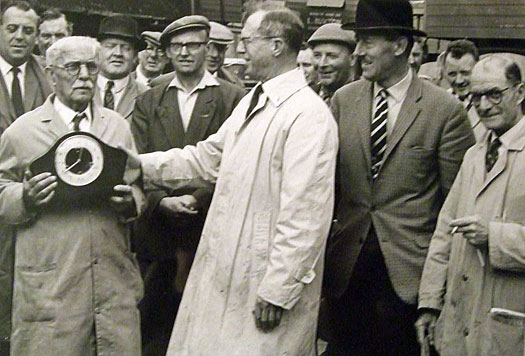


 Market day I believe was Thursday and grandfather then spent the next three working days scrubbing the whole market using only a hose and stiff broom. All the old wet straw he piled up in the back of the market yard and grew the most enormous marrows.
Market day I believe was Thursday and grandfather then spent the next three working days scrubbing the whole market using only a hose and stiff broom. All the old wet straw he piled up in the back of the market yard and grew the most enormous marrows. In the early 1950s I trained at Whitehall Riding School under the instruction of my Uncle, Percy J Rhimes. Those far off times hold many happy memories, and one tends to forget the hard days of freezing cold mornings when the two stable yards were like ice rinks. Sometimes we had to be up at 5.00am to plait manes and tails and have the horses ready for hunting with the Puckeridge Hunt. Those evenings would be tough too, spending hours cleaning good old Hertfordshire mud from horses and tack. Fun times were in abundance as well, polo matches at Silver Leys, riding instruction classes, boarding school students from Whitehall, the Puckeridge point-to-point, and training gallops at Stanstead Airport when the Americans were still stationed there.
In the early 1950s I trained at Whitehall Riding School under the instruction of my Uncle, Percy J Rhimes. Those far off times hold many happy memories, and one tends to forget the hard days of freezing cold mornings when the two stable yards were like ice rinks. Sometimes we had to be up at 5.00am to plait manes and tails and have the horses ready for hunting with the Puckeridge Hunt. Those evenings would be tough too, spending hours cleaning good old Hertfordshire mud from horses and tack. Fun times were in abundance as well, polo matches at Silver Leys, riding instruction classes, boarding school students from Whitehall, the Puckeridge point-to-point, and training gallops at Stanstead Airport when the Americans were still stationed there. Tom Cavell worked at Whitehall and would occasionally bring live rats in traps down from the piggery. My Uncles two Greyhounds (much to my horror) would dispose of them very rapidly. I was delighted to find your photo of Arthur and Sidney Rayment. I regularly rode horses down to the blacksmith to be shod. I distinctly remember Sid being very wary of any horses that were not well behaved, then big Arthur would assert his authority and calm (and submission on the part of the horse-and Sid) would return. I returned to Whitehall in 1970 and was dismayed to see the stables so dilapidated and deserted. I often wonder if they are still there, and the pond that the horses enjoyed splashing in after a hot ride. They sometimes laid down and we had to rescue a rather damp rider.
Tom Cavell worked at Whitehall and would occasionally bring live rats in traps down from the piggery. My Uncles two Greyhounds (much to my horror) would dispose of them very rapidly. I was delighted to find your photo of Arthur and Sidney Rayment. I regularly rode horses down to the blacksmith to be shod. I distinctly remember Sid being very wary of any horses that were not well behaved, then big Arthur would assert his authority and calm (and submission on the part of the horse-and Sid) would return. I returned to Whitehall in 1970 and was dismayed to see the stables so dilapidated and deserted. I often wonder if they are still there, and the pond that the horses enjoyed splashing in after a hot ride. They sometimes laid down and we had to rescue a rather damp rider.